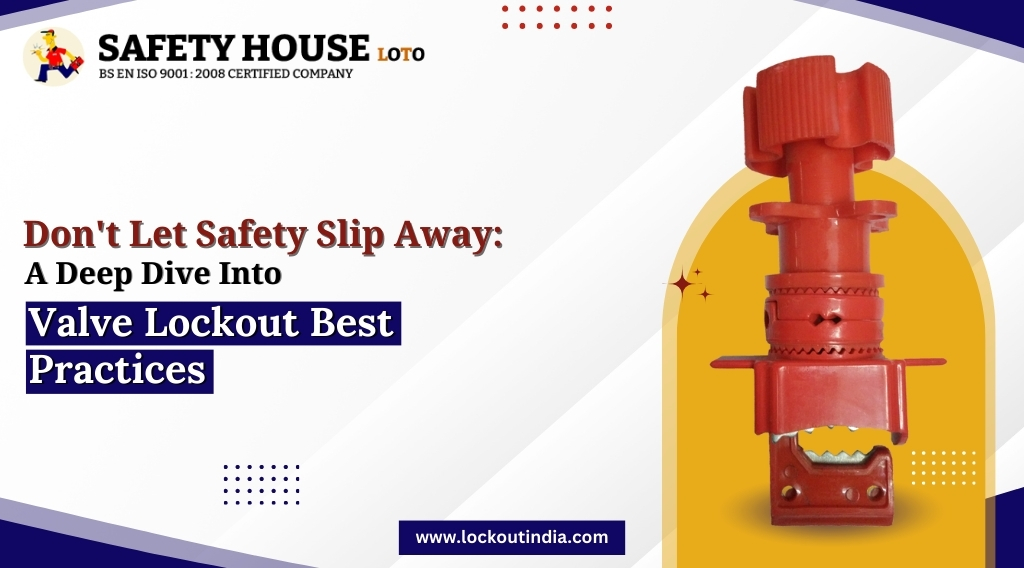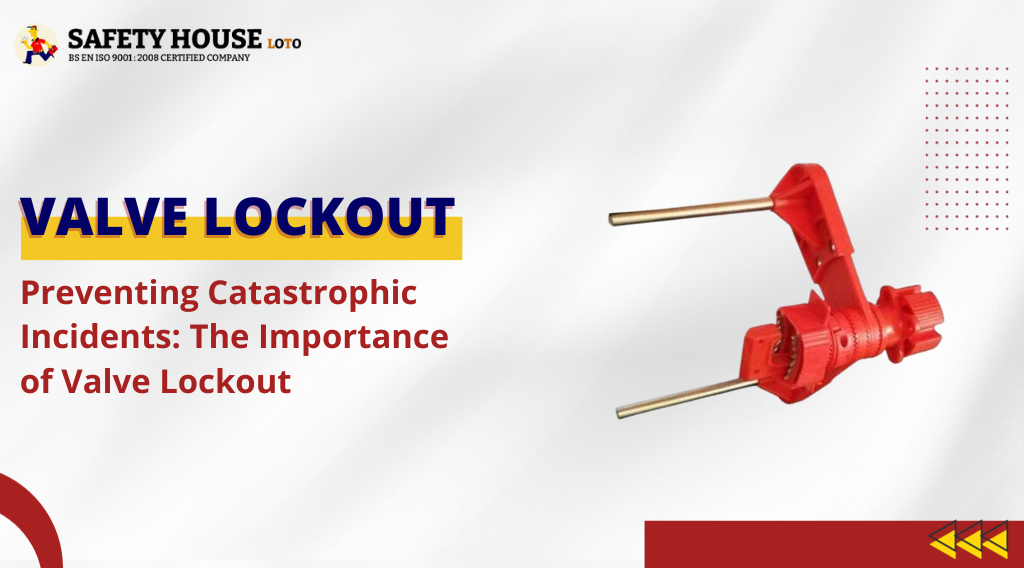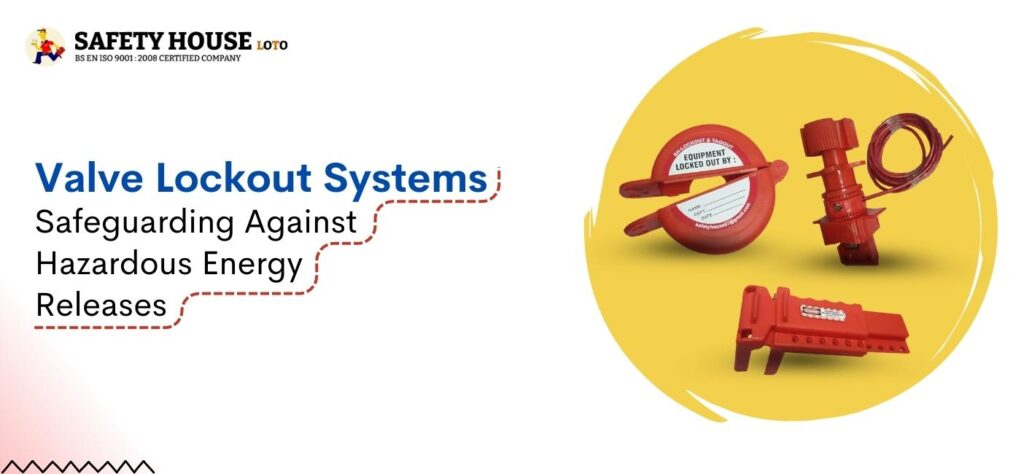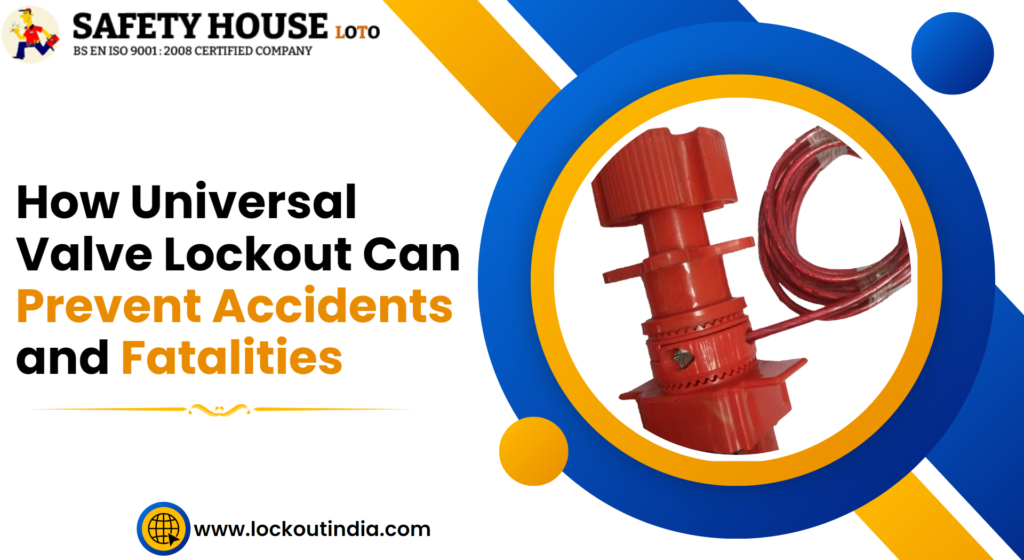
Don’t Let Safety Slip Away: A Deep Dive into Valve Lockout Best Practices
Ensuring Workplace Safety: A Close Examination of Valve Lockout Strategies
In industries where hazardous materials flow through pipelines, valves serve as crucial control points. These valves regulate the flow of liquids, gases, and other substances, ensuring smooth operation. However, when it comes to maintenance, repair, or any situation requiring valve isolation, ensuring safety becomes paramount. This is where valve lockout procedures play a vital role.
Understanding Valve Lockout
Valve lockout is a safety procedure designed to prevent the accidental or unauthorized opening of valves during maintenance or repair work. By using specialized lockout devices, such as padlocks, hasps, and tags, valves are physically locked in a closed or open position, depending on the situation. This prevents unexpected release of hazardous substances, which could lead to accidents, injuries, or environmental damage.
Importance of Valve Lockout
The importance of valve lockout cannot be overstated in industries where safety is a top priority. Failure to properly lock out valves during maintenance or repair activities can result in catastrophic consequences, including chemical spills, fires, explosions, and even loss of life. Therefore, implementing robust valve lockout procedures is essential for protecting personnel, equipment, and the environment.
Key Components of Valve Lockout
A successful valve lockout program consists of several key components:
- Lockout/Tagout (LOTO) Procedures: Comprehensive LOTO procedures should be developed and followed for each valve isolation task. These procedures should include detailed instructions on how to properly lock out valves, including the use of lockout devices and tags.
- Training and Education: Proper training and education are essential for all personnel involved in valve lockout procedures. Employees should be trained on the importance of valve lockout, how to identify lockout points, and how to use lockout devices correctly.
- Lockout Devices: Choosing the right lockout devices is crucial for effective valve lockout. Devices should be durable, tamper-resistant, and capable of withstanding the operating environment. Common lockout devices include valve lockout hasps, ball valve lockouts, and gate valve lockouts.
- Lockout Tags: Lockout tags provide essential information about the status of the valve and the reason for its lockout. Tags should be prominently displayed and include details such as the name of the authorized employee, the date of lockout, and any specific hazards associated with the valve.
Best Practices for Valve Lockout
To ensure the effectiveness of valve lockout procedures, the following best practices should be followed:
- Perform a Risk Assessment: Before initiating any valve lockout procedure, conduct a thorough risk assessment to identify potential hazards and determine the appropriate lockout measures.
- Use Standardized Procedures: Develop standardized lockout procedures for different types of valves and isolation tasks. Ensure that all employees are familiar with these procedures and follow them consistently.
- Implement a Lockout/Tagout Program: Integrate valve lockout procedures into a comprehensive Lockout/Tagout (LOTO) program to ensure consistency and compliance with regulatory requirements.
- Provide Adequate Training: Train all personnel involved in valve lockout procedures on the proper use of lockout devices, the importance of following procedures, and the potential consequences of failure to lock out valves.
- Regular Inspections and Audits: Conduct regular inspections and audits to ensure that valve lockout procedures are being followed correctly. Address any deficiencies or non-compliance issues promptly.
Compliance with Regulations
Compliance with relevant regulations and standards is essential for ensuring the effectiveness of valve lockout procedures. In the United States, the Occupational Safety and Health Administration (OSHA lock) has established specific requirements for lockout/tagout procedures under 29 CFR 1910.147. Similarly, other regulatory bodies around the world have their own guidelines governing lockout procedures. It is imperative for organizations to familiarize themselves with these regulations and ensure compliance to avoid penalties and legal consequences.
Conclusion
Valve lockout is a critical safety procedure that plays a vital role in preventing accidents, injuries, and environmental damage in industries where hazardous materials are present. By implementing robust lockout procedures, providing adequate training, and ensuring compliance with regulations, organizations can protect their personnel, equipment, and the environment from potential harm. Remember, safety should never be compromised, and valve lockout is a crucial step in safeguarding against unforeseen hazards.

Preventing Catastrophic Incidents: The Importance of Valve Lockout
In the intricate dance of industry, where towering machines hum and energy pulses through a labyrinth of pipes, safety waltzes as the lead partner. One misstep, one errant movement, and the harmony erupts into a cacophony of chaos. In this intricate ballet, valves play a crucial role, controlling the flow of vital fluids – liquids and gases that can power cities, fuel production, or, if uncontrolled, unleash devastation. This is where valve lockout steps in, a vital safety measure that can prevent catastrophic incidents before they become headlines.
The Grim Reality: Why Valve Lockout Matters
Industrial accidents involving uncontrolled valve operations are not mere statistics; they are grim reminders of the potential consequences of complacency. From fiery explosions at chemical plants to toxic gas leaks causing mass evacuations, the dangers are real and often fatal. In 2013, a ruptured pipeline in West Virginia sparked a gas explosion that leveled homes and claimed nine lives. In 2019, a faulty valve at a fertilizer plant in Iowa triggered a deadly explosion, wiping out entire buildings and injuring dozens. These tragedies highlight the urgency of robust safety protocols, where valve lockout stands as a sentinel against such incidents.
Understanding Valve Lockout: More than Just a Padlock
Valve lockout goes beyond simply adding a padlock to a valve handle. It’s a comprehensive safety program that involves identifying and isolating energy sources, applying appropriate lockout devices, and verifying their effectiveness. This not only ensures that valves remain in their desired positions during maintenance or repair activities but also prevents accidental activation, protecting both personnel and equipment.
Valve lockout isn’t just a safety measure; it’s a treasure trove of benefits that trickle down to every corner of your industrial operation. It’s like planting a safety seed that blossoms into a bountiful harvest of:
A Feast of Benefits for Every Industry: Valve Lockout
- Enhanced Worker Safety: This is the crown jewel of the valve lockout kingdom. It minimizes the risk of accidental valve operation, protecting your workforce from hazardous energy releases, toxic leaks, and fiery explosions. No more sleepless nights worrying about your team’s well-being!
- Reduced Downtime and Increased Productivity: Say goodbye to scrambling after accidental valve openings that halt production. Valve lockout ensures planned and controlled maintenance, minimizing downtime and keeping your machines humming like a well-oiled symphony. More uptime means more output, more satisfied customers, and bigger smiles all around.
- Boosted Compliance and Lowered Costs: Dodging hefty fines from regulatory bodies is a sweet perk. Valve lockout adherence ensures compliance with safety regulations, saving you the financial sting of non-compliance and potential lawsuits. Think of it as an investment in peace of mind and a lighter wallet.
- Improved Equipment Lifespan: Uncontrolled valve operation is like throwing your equipment into a gladiator arena. Valve lockout shields your machinery from unnecessary wear and tear, extending its lifespan and saving you costly replacements. It’s like gifting your equipment a rejuvenating spa day, keeping it young and vibrant for years to come.
The Valve Lockout Arsenal: Tools for Every Situation
Valve lockout manufacturer in Delhi, and across the globe, offer a diverse range of devices to cater to different valve types and operational needs. These include:
- Ball valve lockouts: Designed for securing ball valves, with options for various handle sizes and locking mechanisms.
- Gate valve lockouts: These robust devices fit onto the valve handles and prevent unauthorized opening or closing.
- Butterfly valve lockouts: Specially designed for butterfly valves, they effectively immobilize the handle.
- Lockout hasps and tags: These versatile tools allow multiple padlocks to be used on a single valve and provide clear identification of lockout procedures.
Choosing the right valve lockout manufacturer in Delhi requires careful consideration of your specific industry, valve types, and safety protocols. Look for manufacturers with a proven track record, certifications, and adherence to international safety standards.
Beyond Tools: Embedding Valve Lockout in Your Safety Culture
While the right tools are essential, valve lockout’s true effectiveness lies in integrating into your safety culture. This involves:
- Training: Thoroughly train all personnel on lockout procedures, identifying different valve types and the appropriate devices.
- Audits and inspections: Regularly conduct audits to ensure compliance with lockout protocols and identify potential hazards.
- Emergency preparedness: Integrate valve lockout procedures into emergency response plans and drills.
By fostering a culture of safety and vigilance, valve lockout transforms from a mere procedure into a powerful shield against preventable incidents.
Valve Lockout: An Investment in Safety, a Guarantee for Progress
Investing in valve lockout is not an expense; it’s an investment in safety, in human lives, and in the continued smooth operation of your enterprise. It’s a guarantee that the intricate dance of industry can continue uninterrupted, free from the discordant notes of catastrophe. So, make valve lockout a cornerstone of your safety culture, choose the right valve lockout manufacturer in Delhi or your region, and ensure that progress flows unimpeded, guided by the steady rhythm of safety.
Remember: Valve lockout is not a one-time fix; it’s a continuous commitment to safety. By prioritizing valve lockout and nurturing a safety-conscious culture, you can prevent incidents, protect lives, and ensure that your organization hums to the tune of success, without ever risking a catastrophic finale.

Valve Lockout Systems: Safeguarding Against Hazardous Energy Releases
In industrial settings, safety is paramount, especially when dealing with potentially hazardous energy sources. Valve lockout systems are indispensable safety lockout products designed to prevent unintended release of energy, securing the well-being of workers and minimizing the risk of accidents. In this article, we’ll explore the significance of valve lockout systems, their benefits, and how they contribute to a safer work environment.
The Role of Valve Lockout Systems in Safety
Valve lockout systems are engineered to isolate valves, preventing their operation during maintenance, repairs, or servicing. They are an essential component of any comprehensive safety lockout program and play a crucial role in safeguarding workers against unexpected energy releases. These systems are particularly effective in environments where various energy sources are present.
Understanding Valve Lockout
Valve lockout systems typically consist of lockout devices that fit over valve handles, preventing them from being turned or operated. These devices are often accompanied by lockout tags and labels, providing clear indications that the valve is locked out for maintenance. By immobilizing valves, these systems reduce the risk of hazardous substances, such as steam, gas, or chemicals, escaping and causing potential harm.
Benefits of Valve Lockout Systems
- Enhanced Worker Safety: Valve lockout systems provide a physical barrier that inhibits unauthorized or accidental valve operation. This minimizes the chances of workers being exposed to dangerous energy releases, contributing to a safer working environment.
- Compliance with Regulations: Implementing valve lockout systems is not only a best practice but also a legal requirement in many industries. Organizations that adhere to safety regulations, such as those outlined by OSHA, showcase their commitment to employee welfare and can avoid costly penalties.
- Versatility in Application: Valve lockout systems can be adapted for various types of valves, including ball valves, gate valves, and butterfly valves. This versatility ensures that different valve systems can be effectively locked out, regardless of their design or function.
How Valve Lockout Systems Work?
- Identification: Identify the valve to be locked out and its energy source.
- Selection: Choose the appropriate valve lockout device based on the valve type and size.
- Application: Attach the lockout device over the valve handle, immobilizing it in the off or closed position.
- Securing: Apply a lockout padlock to the device, ensuring the valve remains in the locked-out state.
- Tagging: Attach a lockout tag indicating the reason for the lockout and the responsible personnel.
Conclusion
Valve lockout systems are pivotal in maintaining a secure working environment, preventing hazardous energy releases that could lead to accidents or injuries. By implementing these safety lockout products, organizations prioritize worker safety, adhere to regulations, and create a culture of responsible energy control. Valve lockout systems stand as a testament to the commitment to safety and employee well-being in any industrial setting.
Remember, investing in quality valve lockout systems and ensuring proper training for employees on their usage is essential for the overall success of your safety lockout program.
Checkout Our Other Products:
- Loto Kit
- Lockout hasp
- Valve lockout
- Lockout station
- Lockout station

How Universal Valve Lockout Can Prevent Accidents and Fatalities?
Valves play a crucial role in the operation of many machines and equipment. However, they can also pose serious safety risks when not properly handled or maintained. In fact, valve-related accidents have caused numerous fatalities and injuries in the workplace over the years. This is where Universal Valve Lockout comes into play! As a lockout supplier and manufacturer of lockout products, we are here to shed some light on how Universal Valve Lockout can prevent accidents and save lives. Keep reading to find out everything you need to know about this essential tool for workplace safety!
What is Universal Valve Lockout?
Universal Valve Lockout is a safety device that ensures valves are locked out and cannot be accidentally or intentionally turned on. It works by fitting tightly over the valve handle, preventing it from being moved. This lockout tagout product can be used in different types of valves such as ball, gate, butterfly and plug valves.
The Universal Valve Lockout device comes with a unique design that allows for easy installation without any special tools. Its bright colour and clear labelling serve as visual warnings to prevent accidental start-ups during maintenance or repair work.
This lockout supplier’s product provides an extra level of protection against the unauthorized use of machinery or equipment. The universal design makes it versatile enough to fit various sizes and styles of valve handles while still providing secure locking mechanisms.
The Universal Valve Lockout is an essential tool in ensuring workplace safety and keeping employees free from harm caused by unexpected hazards.
How Does Universal Valve Lockout Work?
Universal Valve Lockout is an important safety device that helps to prevent accidents and fatalities caused by the uncontrolled release of hazardous energy from valves. But how exactly does this lockout work?
The Universal Valve Lockout device consists of a sturdy base unit, which can be easily attached to the valve wheel using a simple locking mechanism. The base unit has various slots and holes that allow it to fit onto different types and sizes of valve wheels.
Once the base unit is securely fastened, a flexible cable or chain with a padlock can be used to secure the lockout in place, preventing anyone from accidentally opening the valve. This ensures that no one can operate the valve without first removing the lockout device.
In addition to securing valves, Universal Valve Lockouts also feature clear labels or tags that provide instructions on how to use them properly. These labels help ensure that workers understand how to safely operate these devices when needed.
Universal Valve Lockouts are an effective way to keep workers safe when working with machinery and equipment containing hazardous energy sources such as fluids or gases under pressure. With proper training on their use, they can significantly reduce workplace accidents due to accidental operation of valves during maintenance or repair activities.
The implementation of Universal Valve Lockout in the workplace provides numerous benefits that can save lives and prevent accidents. Firstly, it ensures that all equipment is properly locked out to avoid unauthorized access during maintenance or repairs. This minimizes the risk of accidental release of hazardous energy which could result in serious injuries or fatalities.
Secondly, using Universal Valve Lockout promotes compliance with safety regulations such as OSHA’s lockout/tagout standard. Non-compliance can lead to hefty fines and legal consequences for employers.
Thirdly, Universal Valve Lockout devices are versatile and adaptable to different types of valves, making them suitable for use across a variety of industries. They are also easy to install and require minimal training for employees.
Ultimately, investing in Universal Valve Lockout products from reputable lockout suppliers like XYZ Company not only protects workers but also increases productivity by minimizing downtime caused by accidents or equipment damage.
Case Studies of accidents prevented by Universal Valve Lockout
Universal Valve Lockout has proven to be a crucial safety solution in various industries. There are numerous case studies that demonstrate how this lockout tagout product has prevented accidents and saved lives.
One such instance is the case of a manufacturing company where an employee was injured while performing maintenance on a machine. The accident occurred due to the accidental release of stored energy from valves that were not properly locked out. Following this incident, the company implemented Universal Valve Lockout on all their machines, significantly reducing the risk of similar accidents occurring again.
Another example involves a chemical plant where improper valve isolation resulted in an explosion causing severe injuries to several workers. After using Universal Valve Lockout devices, there haven’t been any major untoward incidents at the plant for over five years now.
In yet another instance, a food processing facility experienced near-miss situations due to a failure in locking out critical valves during equipment maintenance procedures. After implementing Universal Valve Lockouts as part of their safety program, they have not faced any such issues since then.
These cases illustrate how powerful Universal Valve Lockouts can be when it comes to preventing workplace accidents and injuries caused by hazardous energy sources. It’s essential for companies across different industries to prioritize employee safety by implementing these types of lockout products into their work processes and procedures.
How to Implement Universal Valve Lockout in the Workplace?
Implementing Universal Valve Lockout in the workplace is a critical step towards ensuring employee safety. The first step to implementation involves assessing all potentially hazardous energy sources and isolating them through tagging and locking out procedures.
Once this assessment is complete, it’s important to select the right lockout tagout products from a reputable manufacturer of lockout products or suppliers. Choose products that are easy to use, durable and can withstand harsh industrial environments.
The next step involves training employees on how to properly use the lockout tagout products. This includes providing clear instructions on how to identify energy sources, apply tags and locks correctly as well as testing equipment prior to releasing any machines for operation.
It’s also important to have regular maintenance checks and audits done on the lockout systems in place. These checks ensure that everything is still working effectively, identifies risks before they become major issues, and ensures compliance with regulatory requirements.
Implementing Universal Valve Lockout requires careful planning, proper product selection, thorough training of employees and regular maintenance checks. By taking these steps seriously you can create a safer work environment for everyone involved.
Conclusion
Universal Valve Lockout is a vital safety tool that prevents accidents and fatalities caused by unexpected release of hazardous energy. It is an essential part of the lockout tagout program that aims to ensure the safety of workers who operate or maintain machines and equipment in industrial settings.
By implementing Universal Valve Lockout, employers can comply with OSHA regulations, reduce insurance costs, improve productivity, and most importantly protect their workers from harm.
As a leading supplier and manufacturer of lockout products, we at Safety House Loto recommend using our high-quality Universal Valve Lockouts for your workplace safety needs. Our products are designed to fit most valves regardless of size or shape, ensuring maximum security for your employees.
Don’t compromise on safety – invest in reliable lockout tagout products like Universal Valve Lockouts today!

What Is Valve Lockout Devices And Its Uses?
Have you ever heard about the valve lockout device? It is the safety device accessed for effective lockout procedures in the work environment.
It allows the industry workers to isolate or close off the stored energy such as electricity and hydraulic pressures. The major purpose of valve lockout is to prevent harmful accidents during repairs and maintenance.
In simple words, the valve lockout is used to close off pressured valves to make sure that the machinery, which is valve operated, remains switched off when workers are performing maintenance work.
Moreover, this device is often attached over the valve’s operational part before securing it in place with the hasps or padlocks. If you want to know about the valve lockout device uses, then you should read the below section carefully.
Features of the valve lockout
Upon reading the above section, you will know the important purpose of valve lockout. Here are the potential features of the valve lockout. In addition, it helps you understand the importance of spending on this device.
- Valve lockout is extremely easy to use and install
- It is made of nylon and industrial-grade steel material for durability
- It is powerful enough to lock commonly accessed sizes of pressured valves at the right angles.
- The valve lockout device has excellent resistance to corrosion, high temperature, and solubility.
- It has a high safety factor and has become applicable to different manufacturing fields.
Uses of the valve lockout devices
The purpose of valve lockout is extensive, and thus it is widely used in different industries where safety is a big concern. You can use the valve lockout for the valves that contain storage tanks, gate valves, shut-off valves, and much more.
However, the valve lockout helps eliminate the industrial mishappenings throughout the world caused by unanticipated equipment startups and unexpected energy releases.
Furthermore, even though valve lockout device uses are diverse, the most highlighted usage is that it locks most types and sizes of valves. It ensures safety and gives ultimate protection to the workers. It has become the must-have equipment in the industry where the risk of injury and accident is high for the workers.
Since it acts as the best investment compared to the disposable and environmentally unsustainable alternative, you will save more of your money.
Moreover, to avoid hassles, you should choose the right valve lockout suitable for your industrial requirements. Most importantly, you should join hands with the reliable Safety Lockout Products manufacturer to get high-quality devices.
As you have realized, do you want to purchase the best quality valve lockout devices? Well! You can shop at a reliable destination and get high-quality lockout values at a reasonable rate.
Top Valve Lockout Devices From Safety House Loto




